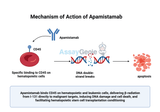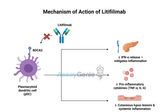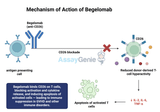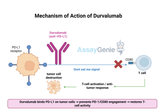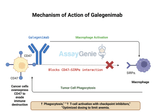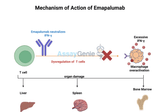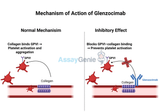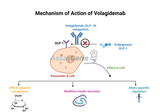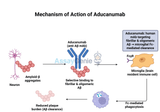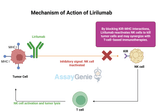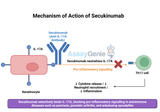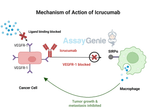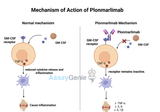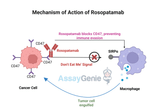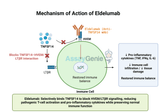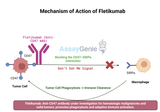Blog
Apamistamab: Advancing Leukemia Treatment through Targeted Radioimmunotherapy
Quick Facts About ApamistamabWhat is Apamistamab?Apamistamab is a monoclonal antibody that targets the CD45 antigen on hematopoietic cells.How does Apamistamab work?When labeled with the radioactive isotope Iodine-131, Apamistamab delivers targeted radiation to CD45-expressing cells, aiding in the eradication of malignant cells.What are the clinical applications of Apamistamab?Apamistamab is primarily used in conditioning regimens before hematopoietic cell transplantation for patients with relapsed or refractory acute myeloid leukemia (AML).1.) Understanding ApamistamabApamistamab, also known as Iomab-B when conjugated with Iodine-131, is an innovative therapeutic agent designe
…
11th Mar 2025
Litifilimab: A Promising Anti-BDCA2 Antibody for Lupus Treatment
Quick Facts About LitifilimabWhat is Litifilimab?Litifilimab is a monoclonal antibody developed by Biogen targeting BDCA2, a receptor on plasmacytoid dendritic cells (pDCs), to regulate immune response in lupus.What is the mechanism of action of Litifilimab?Litifilimab inhibits BDCA2, reducing inflammatory cytokine production and modulating the immune system, potentially benefiting lupus patients.What are the clinical applications of Litifilimab?Litifilimab is being investigated for systemic lupus erythematosus (SLE) and cutaneous lupus erythematosus (CLE), with Phase 3 trials ongoing.1.) Understanding LitifilimabDeveloped by Biogen, Litifilimab has shown promising results in e
…
11th Mar 2025
Begelomab: Mechanism of Action, Clinical Applications & Biosimilars
Quick Facts About BegelomabWhat is Begelomab?Begelomab is a monoclonal antibody that targets CD26, a key molecule involved in immune regulation. It has been studied for its potential applications in treating T-cell mediated disorders, including graft-versus-host disease (GVHD).How Does Begelomab Work?Begelomab binds to CD26, modulating immune responses by affecting T-cell activation and signaling pathways. This makes it a promising candidate for managing autoimmune conditions and post-transplant complications.What Are the Clinical Applications of Begelomab?Begelomab has been explored in clinical settings for treating steroid-refractory acute GVHD, a severe complication followin
…
8th Mar 2025
Durvalumab: Advancing Immunotherapy in Cancer Treatment
Quick Facts About DurvalumabWhat is Durvalumab?Durvalumab (Imfinzi) is a PD-L1 checkpoint inhibitor used in immunotherapy to treat various cancers, including non-small cell lung cancer (NSCLC) and small cell lung cancer (SCLC).How does Durvalumab work?Durvalumab blocks PD-L1, restoring the immune system's ability to recognize and attack cancer cells.What are the clinical applications of Durvalumab?It is FDA-approved for treating NSCLC, SCLC, and biliary tract cancer and is being explored in combination therapies.What are the side effects of Durvalumab?Common side effects include fatigue, cough, and immune-related reactions such as pneumonitis and colitis.1.) Understanding Durva
…
8th Mar 2025
Galegenimab: Unlocking the Potential of Anti-CD47 in Cancer Research
Quick Facts About GalegenimabWhat is Galegenimab?Galegenimab is an anti-CD47 monoclonal antibody designed to block the "don't eat me" signal, enhancing the immune system's ability to eliminate cancer cells.How Does Galegenimab Work?By targeting CD47, Galegenimab prevents cancer cells from evading macrophage-mediated phagocytosis, a critical mechanism in immune response.What Are the Clinical Applications of Galegenimab?Galegenimab is being investigated for its potential in treating hematologic malignancies and solid tumors, particularly in combination with other immunotherapies.1.) Understanding GalegenimabGalegenimab represents a significant advancement in immuno-oncology by ta
…
8th Mar 2025
Emapalumab: Unlocking the Potential of Targeting IFN-γ in HLH Treatment
Quick Facts About EmapalumabWhat is Emapalumab?Emapalumab is a fully human monoclonal antibody that neutralizes interferon-gamma (IFN-γ). It is the first FDA-approved therapy for primary HLH, a life-threatening hyperinflammatory condition.What is the mechanism of action of Emapalumab?Emapalumab binds to and neutralizes IFN-γ, reducing excessive immune activation in HLH patients. By targeting this key cytokine, it helps control inflammation and prevent tissue damage.What are the clinical applications of Emapalumab?Emapalumab is primarily used to treat pediatric and adult patients with primary HLH who are unresponsive to conventional treatments. It is also being explored for seco
…
8th Mar 2025
Glenzocimab: A Novel Antiplatelet Therapy for Stroke Prevention
Quick Facts About GlenzocimabWhat is Glenzocimab?Glenzocimab is an innovative monoclonal antibody designed to reduce the risk of ischemic stroke by selectively targeting platelet glycoprotein VI (GPVI).How does Glenzocimab work?By inhibiting GPVI, Glenzocimab prevents excessive platelet aggregation while preserving normal hemostasis, reducing the likelihood of thrombotic events.What are the clinical applications of Glenzocimab?Glenzocimab is primarily investigated for its role in treating acute ischemic stroke (AIS) and preventing recurrent strokes in high-risk patients.1.) Understanding GlenzocimabGlenzocimab is a first-in-class monoclonal antibody designed to offer a safer an
…
8th Mar 2025
Vixarelimab: A Novel Approach to Targeting Prurigo Nodularis and Fibrosis
Quick Facts About VixarelimabWhat is Vixarelimab?Vixarelimab is an investigational monoclonal antibody developed to target oncostatin M receptor beta (OSMRβ), a key pathway involved in pruritus and fibrosis.What is the mechanism of action for Vixarelimab?Vixarelimab works by inhibiting OSMRβ, which plays a crucial role in inflammatory and fibrotic signaling. By blocking this pathway, it may help reduce itch severity and fibrosis progression in certain diseases.What are the clinical applications of Vixarelimab?Vixarelimab has been investigated for prurigo nodularis (PN) and idiopathic pulmonary fibrosis (IPF). Research is also exploring its potential for other fibrotic condition
…
8th Mar 2025
Volagidemab: A Breakthrough in GLP-1 Receptor Agonists for Metabolic Disorders
Quick Facts About VolagidemabWhat is Volagidemab?Volagidemab is a glucagon-like peptide-1 (GLP-1) receptor antagonist designed to regulate glucose metabolism and energy homeostasis.How Does Volagidemab Work?It blocks the GLP-1 receptor, preventing its activation by natural ligands, thereby influencing insulin secretion and glucose regulation.What Are the Clinical Applications of Volagidemab?Volagidemab has been investigated for metabolic disorders, particularly type 2 diabetes and obesity, with research exploring its potential in controlling blood sugar levels and weight management.1.) Understanding VolagidemabVolagidemab is a novel therapeutic agent targeting the glucagon-like
…
8th Mar 2025
Aducanumab: Mechanism, Clinical Applications, and the Role of Biosimilars in Research
Quick Facts About AducanumabWhat is Aducanumab?Aducanumab is a monoclonal antibody designed to target and reduce amyloid-beta plaques in the brain, a hallmark of Alzheimer’s disease.What is the mechanism of action for Aducanumab?Aducanumab selectively binds to aggregated amyloid-beta, facilitating its clearance via microglial phagocytosis and reducing plaque burden in Alzheimer’s patients.What are the clinical applications of Aducanumab?Aducanumab is approved for the treatment of Alzheimer’s disease, with a focus on early-stage cases to slow cognitive decline.Why is Aducanumab controversial?The drug’s accelerated FDA approval raised debates regarding clinical efficacy, safety c
…
8th Mar 2025
Lirilumab: Unlocking the Potential of Anti-KIR Therapy in Cancer Research
Quick Facts About LirilumabWhat is Lirilumab?Lirilumab is an anti-KIR monoclonal antibody designed to enhance natural killer (NK) cell activity by blocking killer-cell immunoglobulin-like receptors (KIRs), which inhibit NK cell function.How Does Lirilumab Work?By targeting inhibitory KIRs on NK cells, Lirilumab prevents these cells from being suppressed by tumor cells, potentially enhancing immune-mediated cancer cell elimination.What Are the Clinical Applications of Lirilumab?Lirilumab has been investigated in clinical trials for hematologic malignancies and solid tumors, often in combination with other immunotherapies like nivolumab.1.) Understanding LirilumabLirilumab, a mon
…
8th Mar 2025
Secukinumab: A Comprehensive Guide to Its Mechanism, Applications, and Biosimilar Advancements
Quick Facts About SecukinumabWhat is SecukinumabSecukinumab is a monoclonal antibody that targets interleukin-17A (IL-17A), a key cytokine involved in inflammatory and autoimmune responses.How Does Secukinumab Work?It binds to IL-17A, preventing it from interacting with its receptor, thereby reducing inflammation associated with conditions like psoriasis and ankylosing spondylitis.What Are the Clinical Applications of Secukinumab?Secukinumab is approved for treating moderate-to-severe plaque psoriasis, psoriatic arthritis, ankylosing spondylitis, and hidradenitis suppurativa.What Are the Side Effects of Secukinumab?Common side effects include upper respiratory infections, heada
…
8th Mar 2025
Validation of MycoGenie Rapid Mycoplasma Detection Kit - A highly sensitive visual determination method for Mycoplasma detection.
The MycoGenie Rapid Mycoplasma Detection Kit enables the detection of 28 Mycoplasma species in under 1 hour using a simple visual determination method, eliminating the need for expensive equipment and complex protocols. The kit demonstrated a detection limit of 3.07 × 10² Mycoplasma copies, matching the sensitivity of the "Gold Standard" qPCR method. The assay utilizes an isothermal amplification method with a colorimetric readout, allowing easy, rapid, and reliable detection without specialized training. The MycoGenie kit is compatible with a wide range of cell types and culture media, making it a versatile solution for cell culture laboratories. Mycoplasma contamination was s
…
3rd Mar 2025
3D Organoid Cell Viability Assay: Performance Assessment in Human Colon Organoids
The 3D Organoid Cell Viability Assay (AKES081) demonstrated high sensitivity and low cytotoxicity, making it ideal for long incubation studies (24-48 hours) and high-throughput applications. AKES081 effectively quantified live cell numbers in human colon organoids using WST-8 reduction, providing a direct correlation between viability and optical density at 450 nm. AKES081 confirmed expected cytotoxic effects of 5-fluorouracil (5-FU), with decreasing organoid survival at increasing drug concentrations, validating its suitability for drug screening applications. The one-step, wash-free protocol enabled easy viability assessment and allowed for subsequent RNA extraction for gene
…
3rd Mar 2025
Compatibility and Performance Assessment of the GenieColor Mycoplasma Detection Kit Across Diverse Laboratory Conditions
MORV0013 functioned effectively in both qPCR machines and water baths, with or without paraffin oil, maintaining consistent sensitivity and specificity. MORV0013 performed reliably between 60°C and 67°C, ensuring accurate mycoplasma detection even in instruments with varying temperature precision. MORV0013 maintained specificity and accuracy over extended reaction times (2 hours), demonstrating robustness for prolonged testing conditions. MORV0013 successfully detected mycoplasma in multiple cell culture types (suspension and adherent, human and mouse), confirming broad applicability. Different culture media and serum types had no significant effect on amplification speed, sens
…
3rd Mar 2025
3D Respiratory Organoids Cell Viability in a High-throughput 384-well Plate Assay
The Assay Genie 3D Organoid Cell Viability Assay (AKES081) provided superior results compared to ThermoScientific PrestoBlue, maintaining over 100% viability at all time points in untreated 3D apical-out airway organoids. AKES081 detected reduced cell viability (0.5% to 5.9%) when organoids were treated with 10% DMSO, demonstrating its ability to accurately measure cytotoxic effects. AKES081 maintained consistent and reliable readings across 1-hour, 3-hour, and overnight incubations, making it suitable for high-throughput and long-term studies. Unlike resazurin-based methods, the WST-8-based assay provided more stable results with minimal interference, allowing for extended inc
…
3rd Mar 2025
Comparison of Assay Genie Dual Luciferase Reporter Assay (MORV0010) vs Promega (E1910): Performance Evaluation of Quenching Efficiency and Auto-luminescence
Both Assay Genie MORV0010 and Promega E1910 effectively quenched Firefly luciferase before Renilla detection, minimizing signal overlap. E1910 achieved 99.95% quenching efficiency, while MORV0010 achieved 99.90%, ensuring accurate dual luciferase measurements. MORV0010 maintained low background luminescence (680 RLU) comparable to E1910 (639 RLU), ensuring sensitive Renilla luciferase detection without interference. MORV0010 exhibited slightly higher initial Firefly luminescence values, offering robust signal strength for detecting gene expression changes. Despite its economical pricing, the Assay Genie Dual Luciferase Reporter Assay Kit (MORV0010 ) delivers results comparable
…
3rd Mar 2025
3D Organoid Cell Viability Assay: Assessing Environmental Stress on BENOs for Live Delivery
3D Organoid Cell Viability Assay (AKES081) effectively measures BENO model viability across different storage conditions. AKES081 detects significant viability differences, particularly the negative impact of +4°C (fridge) storage over time, confirming its sensitivity to environmental stress. AKES081 successfully differentiates viability effects based on temperature and duration, while flask sealing (O₂ concentration) shows no significant influence. Raw absorbance values and ANOVA analysis confirm AKES081 ability to detect statistically significant differences between control and test conditions. AKES081 provides a reliable tool for evaluating viability in live BENO delivery, b
…
3rd Mar 2025
Automation of MR-proANP and MR-proADM ELISA Kits on Dynex DS2 Instrument
The Dynex DS2 platform fully automates the MR-proANP and MR-proADM ELISA assays, streamlining sample processing from loading to detection. Automation ensures consistent assay performance with a coefficient of variation (CV) below 10%, minimizing variability across runs. The system enables high-throughput analysis of multiple 96-well plates, making it ideal for large-scale biomarker research. Hands-on time is significantly reduced, allowing researchers to focus on other tasks without compromising data quality. The automated workflow maintains assay sensitivity and linearity, ensuring accurate biomarker quantification for cardiovascular research applications.Automation of MR-proA
…
3rd Mar 2025
Icrucumab: Exploring the Role of Anti-Angiogenic Therapy in Cancer Research
Quick Facts About IcrucumabWhat is Icrucumab?Icrucumab is a monoclonal antibody that targets vascular endothelial growth factor receptor-1 (VEGFR-1) to inhibit tumor angiogenesis.How Does Icrucumab Work?By blocking VEGFR-1, Icrucumab prevents tumor blood vessel formation, limiting cancer growth and metastasis.What Are the Clinical Applications of Icrucumab?Icrucumab has been investigated for various cancers, including colorectal and lung cancers, though research is ongoing to determine its efficacy.1.) Understanding IcrucumabIcrucumab is a humanized monoclonal antibody developed to target vascular endothelial growth factor receptor 1 (VEGFR-1), a crucial mediator of tumor angio
…
27th Feb 2025
Plonmarlimab: Advancing Anti-GM-CSF Therapy in Inflammatory Diseases
Quick Facts About PlonmarlimabWhat is Plonmarlimab?Plonmarlimab is a monoclonal antibody targeting GM-CSF, a cytokine involved in inflammation and immune responses.How does Plonmarlimab work?It inhibits GM-CSF, reducing inflammatory cytokine release and immune cell activation, making it a potential treatment for autoimmune conditions.What are the clinical applications of Plonmarlimab?It has been studied in conditions like rheumatoid arthritis and COVID-19-induced hyperinflammation.Is Plonmarlimab safe?Early trials suggest a favorable safety profile, but ongoing research continues to evaluate long-term effects.1.) Understanding PlonmarlimabPlonmarlimab is a humanized monoclonal
…
27th Feb 2025
Rosopatamab: Unveiling the Potential of Anti-CD47 Therapy in Cancer Research
Quick Facts About RosopatamabWhat is Rosopatamab?Rosopatamab is a monoclonal antibody targeting CD47, a critical immune checkpoint that helps cancer cells evade immune detection. By blocking CD47, Rosopatamab enhances macrophage-mediated phagocytosis of cancer cells.What is the mechanism of action for Rosopatamab?Rosopatamab binds to CD47, preventing its interaction with SIRPα on macrophages. This action disrupts the “don’t eat me” signal, allowing the immune system to recognize and destroy malignant cells.What are the clinical applications of Rosopatamab?Rosopatamab is being explored in clinical research for treating hematologic malignancies and solid tumors. Studies suggest i
…
27th Feb 2025
Eldelumab: Unlocking the Potential of Anti-TNFSF14 in Inflammatory Diseases
Quick Facts About EldelumabWhat is Eldelumab?Eldelumab is a monoclonal antibody targeting TNFSF14 (LIGHT), a key regulator in immune system signaling, with potential applications in inflammatory diseases.How does Eldelumab work?Eldelumab blocks the interaction between TNFSF14 and its receptors, reducing excessive immune activation linked to conditions such as inflammatory bowel disease (IBD) and rheumatoid arthritis.What are the clinical applications of Eldelumab?Eldelumab has been investigated in autoimmune diseases, particularly ulcerative colitis and Crohn’s disease, for its role in modulating inflammatory pathways.1.) Understanding EldelumabEldelumab is a human monoclonal a
…
26th Feb 2025
Fletikumab: Unlocking the Potential of Anti-CD47 Therapy in Cancer Research
Quick Facts About FletikumabWhat is Fletikumab?Fletikumab is an investigational monoclonal antibody targeting CD47, a key immune checkpoint that enables cancer cells to evade immune destruction.How Does Fletikumab Work?Fletikumab blocks CD47, a "don’t eat me" signal used by cancer cells, allowing macrophages and other immune cells to identify and destroy malignant cells more effectively.What Are the Clinical Applications of Fletikumab?Ongoing research explores Fletikumab’s potential in treating various cancers, particularly hematologic malignancies and solid tumors, by enhancing immune-mediated tumor clearance.Is Fletikumab Safe?While promising, early studies indicate potential
…
26th Feb 2025

